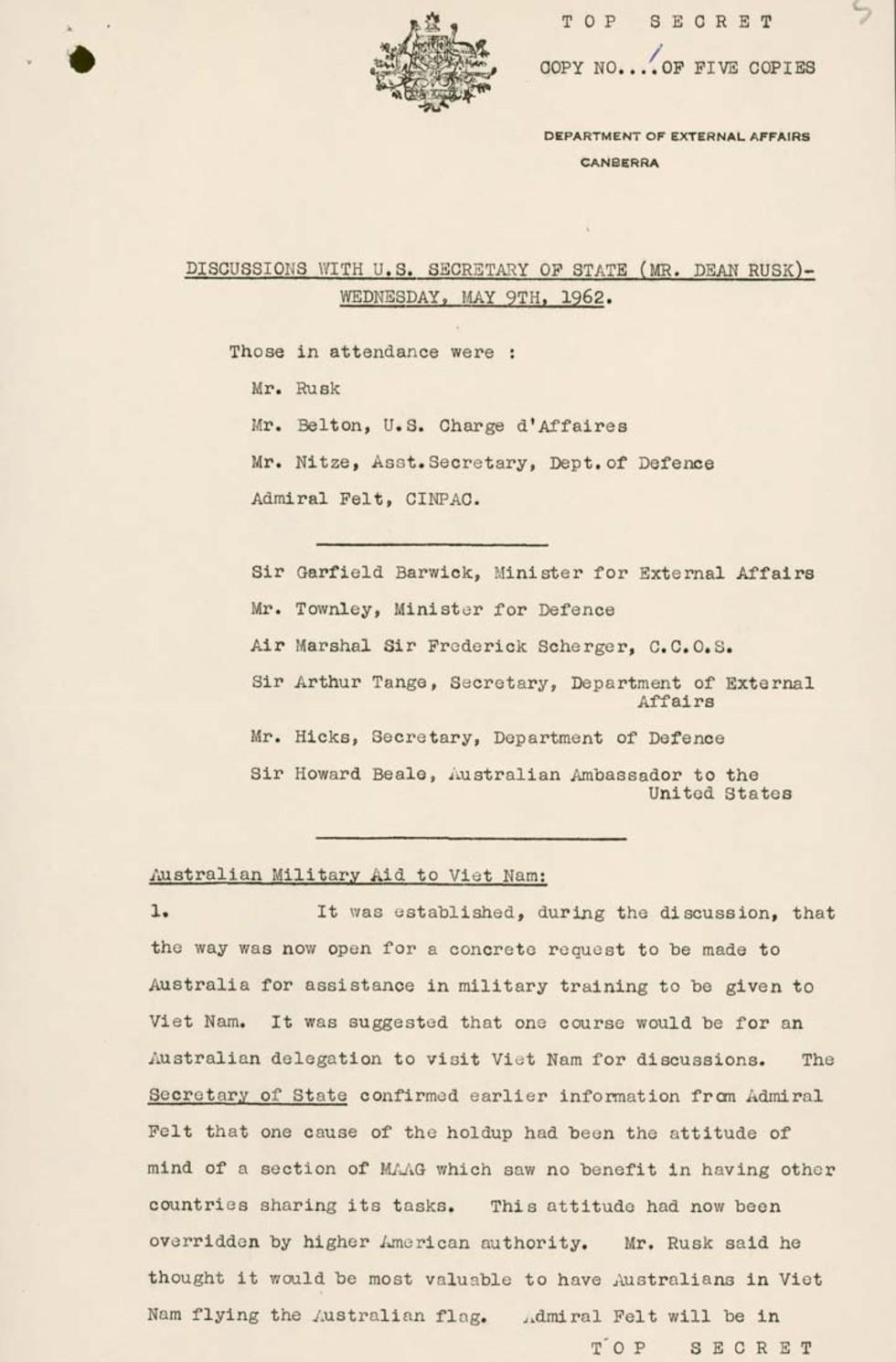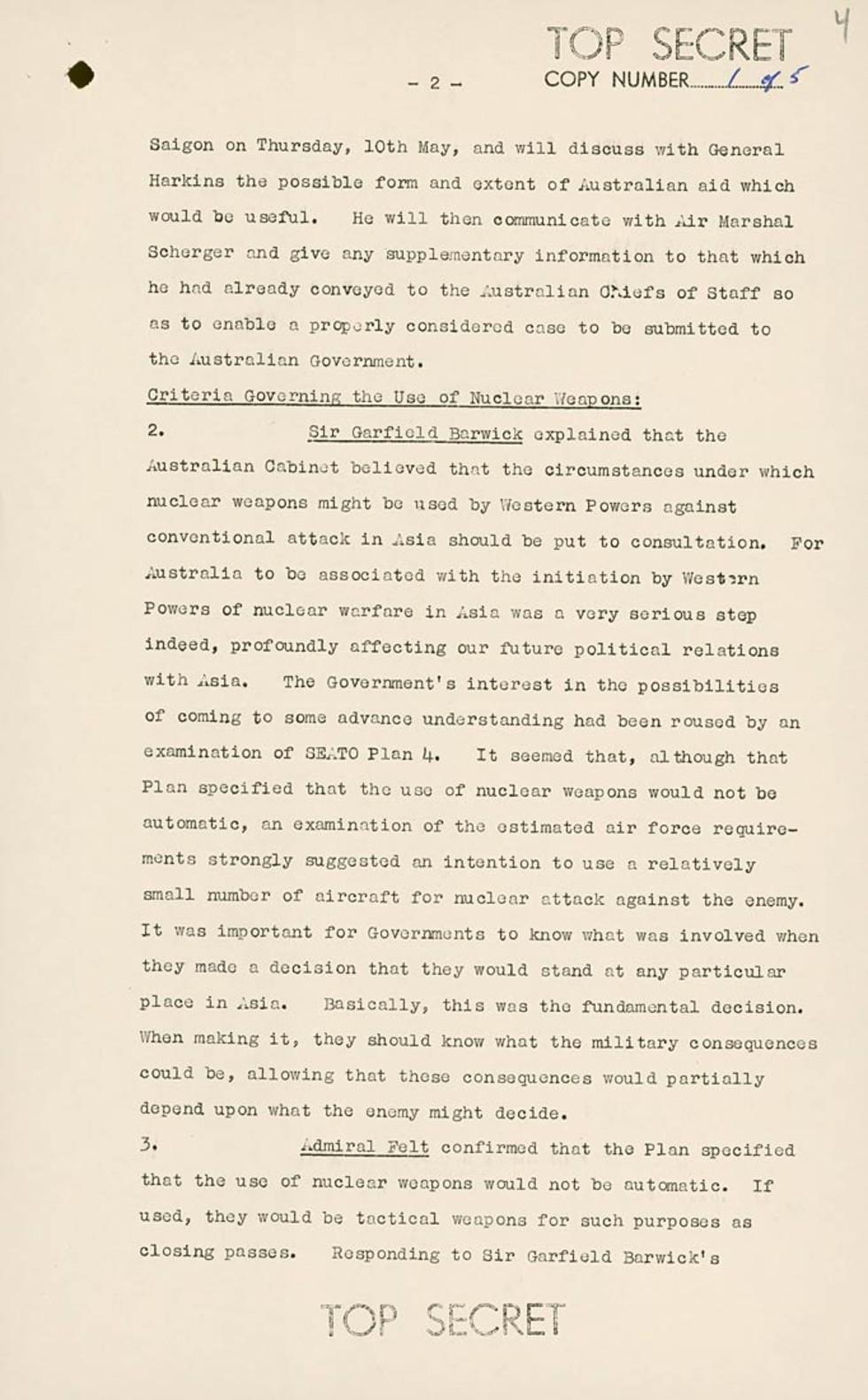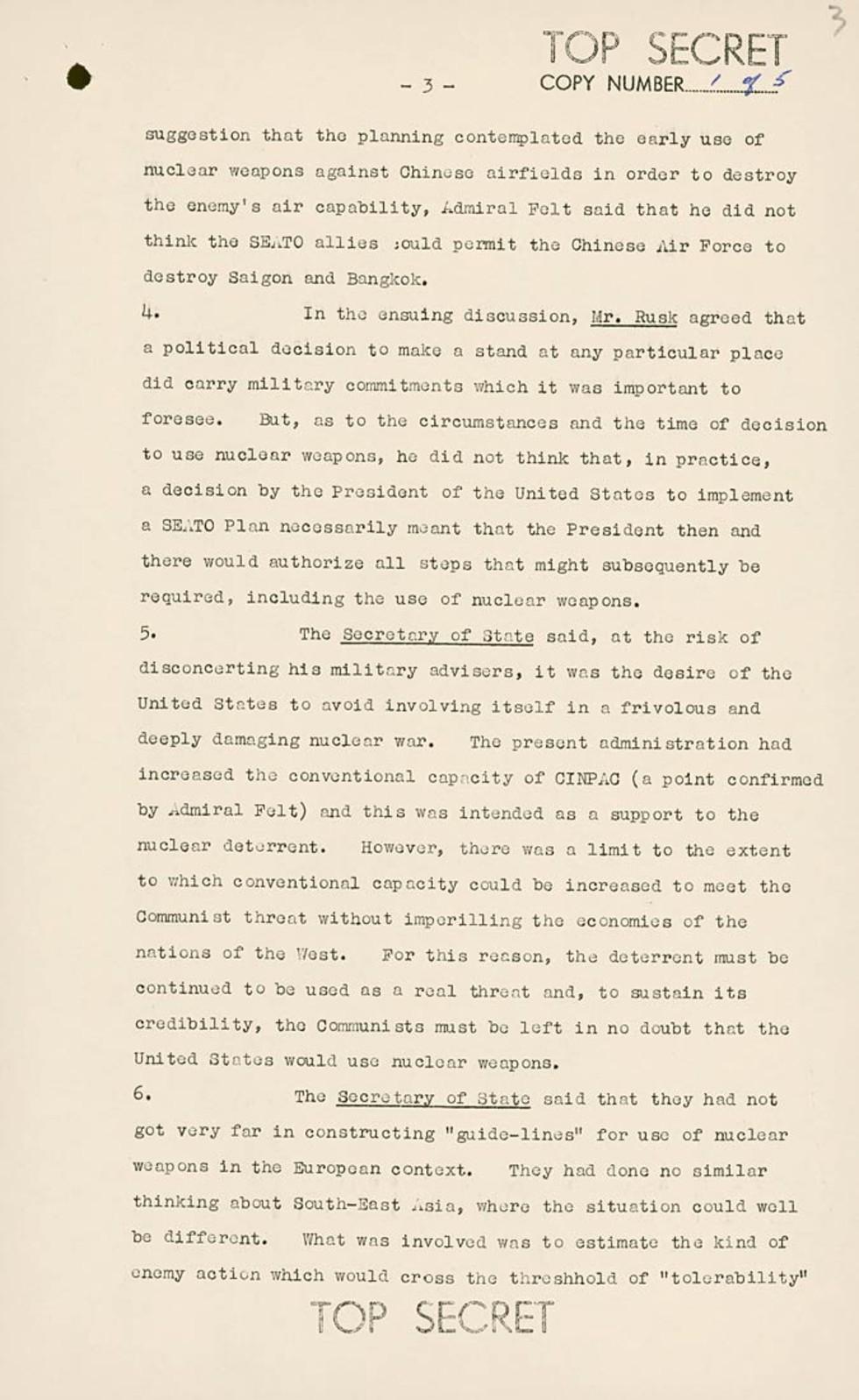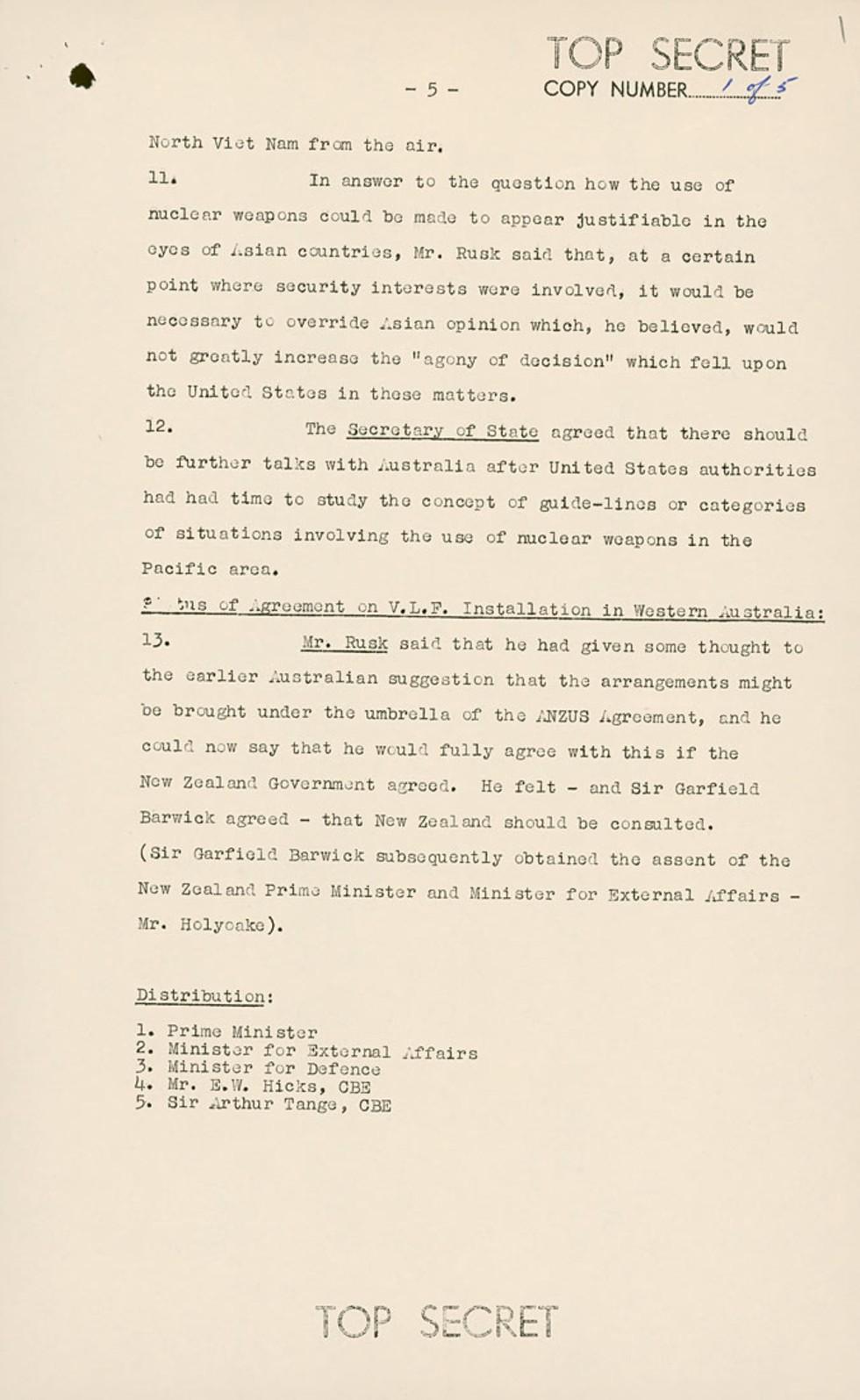




Aboriginal and Torres Strait Islander people should be aware that the National Archives' website and collection contain the names, images and voices of people who have died.
Some records include terms and views that are not appropriate today. They reflect the period in which they were created and are not the views of the National Archives.






[Page 1]
[Letterhead in black ink with Australian Commonwealth Coat of Arms and the text ‘DEPARTMENT OF EXTERNAL AFFAIRS CANBERRA’]
[Typed at top and bottom of the page] TOP SECRET
COPY NO. 1 OF FIVE COPIES
[Underlined heading] DISCUSSIONS WITH U.S. SECRETARY OF STATE (MR. DEAN RUSK) – WEDNESDAY, MAY 9TH, 1962.
Those in attendance were :
Mr. Rusk
Mr. Belton, U.S. Charge d’Affaires
Mr. Nitze, Asst. [Assistant] Secretary, Dept. [Department] of Defence
Admiral Felt, CINPAC. [Commander in Chief of Pacific Command]
[Line break]
Sir Garfield Barwick, Minister for External Affairs
Mr. Towney, Minister for Defence
Air Marshal Sir Frederick Scherger, C.C.O.S. [Chairman of the Chiefs of Staff Committee]
Sir Arthur Tange, Secretary, Department of External Affairs
Mr. Hicks, Secretary, Department of Defence
Sir Howard Beale, Australian Ambassador to the United States
[Line break]
[Underlined subheading] Australian Military Aid to Viet Nam:
1. It was established, during the discussion, that the way was now open for a concrete request to be made to Australia for assistance in military training to be given to Viet Nam. It was suggested that one course would be for an Australian delegation to visit Viet Nam for discussions. The [underlined] Secretary of State [end underline] confirmed earlier information from Admiral Felt that one cause of the holdup had been the attitude of mind of a section of MAAG [Military Assistance Advisory Group] which saw no benefit in having other countries sharing its tasks. This attitude had now been overridden by higher American authority. Mr. Rusk said he thought it would be most valuable to have Australians in Viet Nam flying the Australian flag. Admiral Felt will be in
[Page] -2-
[Header and footer] TOP SECRET
COPY NUMBER [handwritten] 1 of 5 [end handwritten]
Saigon on Thursday, 10th May, and will discuss with General Harkins the possible form and extent of Australian aid which would be useful. He will then communicate with Air Marshal Scherger and give any supplementary information to that which he had already conveyed to the Australian Chiefs of Staff so as to enable a properly considered case to be submitted to the Australian Government.
[Underlined subheading] Criteria Governing the Use of Nuclear Weapons:
2. Sir Garfield Barwick [underlined] explained that the Australian Cabinet believed that the circumstances under which nuclear weapons might be used by Western Powers against conventional attack in Asia should be put to consultation. For Australia to be associated with the initiation by Western Powers of nuclear warfare in Asia was a very serious step indeed, profoundly affecting our future political relations with Asia. The Government’s interest in the possibilities of coming to some advance understanding had been roused by an examination of SEATO [Southeast Asia Treaty Organisation] Plan 4. It seemed that, although that Plan specified that the use of nuclear weapons would not be automatic, an examination of the estimated air force requirements strongly suggested an intention to use a relatively small number of aircraft for nuclear attack against the enemy. It was important for Governments to know what was involved when they made a decision that they would stand at any particular place in Asia. Basically, this was the fundamental decision. When making it, they should know what the military consequences could be, allowing that these consequences would partially depend upon what the enemy might decide.
3. Admiral Felt [underlined] confirmed that the Plan specified that the use of nuclear weapons would not be automatic. If used, they would be tactical weapons for such purposes as closing passes. Responding to Sir Garfield Barwick’s
[Page] -3-
[Header and footer] TOP SECRET
COPY NUMBER [handwritten] 1 of 5 [end handwritten]
suggestion that the planning contemplated the early use of nuclear weapons against Chinese airfields in order to destroy the enemy’s air capability, Admiral Felt said that he did not think the SEATO allies could permit the Chinese Air Force to destroy Saigon and Bangkok.
4. In the ensuing discussion, Mr. Rusk [underlined] agreed that a political decision to make a stand at any particular place did carry military commitments which it was important to foresee. But, as to the circumstances and the time of decision to use nuclear weapons, he did not think that, in practice, a decision by the President of the United States to implement a SEATO Plan necessarily meant that the President then and there would authorize all steps that might subsequently be required, including the use of nuclear weapons.
5. The Secretary of State [underlined] said, at the risk of disconcerting his military advisors, it was the desire of the United States to avoid involving itself in a frivolous and deeply damaging nuclear war. The present administration had increased the conventional capacity of CINPAC [Commander in Chief of Pacific Command] (a point confirmed by Admiral Felt) and this was intended as a support to the nuclear deterrent. However, there was a limit to the extent to which conventional capacity could be increased to meet the Communist threat without imperilling the economies of the nations of the West. For this reason, the deterrent must be continued to be used as a real threat and, to sustain its credibility, the Communists must be left in no doubt that the United States would use nuclear weapons.
6. The Secretary of State [underlined] said that they had not got very far in constructing “guide-lines” [sic] for use of nuclear weapons in the European context. They had done no similar thinking about South-East Asia, where the situation could well be different. What was involved was to estimate the kind of enemy action which would cross the threshhold [sic] of “tolerability”
[Page] -4-
[Header and footer] TOP SECRET
COPY NUMBER [handwritten] 1 of 5 [end handwritten]
and make an allied nuclear response inevitable.
7. Mr. Nitze [underlined] observed that the Russians also have a problem in estimating the intentions of our side. He thought that, while we might confine resistance to aggression to conventional means for a considerable time, there should be some “overlap” with the nuclear deterrent in the sense that the enemy must be brought to believe at an early stage that there was a possibility of the nuclear weapon being used against them.
8. Sir Garfield Barwick [underlined] said that what he had in mind was that there should be some consultations in an effort to see whether situations could be categorized in advance so that Governments knew what were the potentialities when authorizing the commitment of national forces and prestige to situations which included limited counter insurgency actions. In his own view some military situations which were difficult should be bearable without using nuclear weapons. He noted that Admiral Felt had suggested that the decision must be quick.
9. Mr. Rusk [underlined] said he had a reluctance in having papers drafted on this kind of thing. They could be misleading: and he quoted the case of a Chiefs of Staff paper drawn in 1947 which stated that, in the global context, Korea had no great strategic importance. It did not purport to answer the question arising in 1950 whether it was important to defend Korea against a direct attack confined to Korea.
10. Mr. Rusk [underlined] said that the United States is not straining at the leash to make an early use of nuclear weapons in Asia. It might well want to make an early conventional attack of a harrassing [sic] kind into enemy territory as a warning and deterrent – for example, if the time came when it had to be accepted that there were North Vietnamese troops invading South Viet Nam, the answer might be to attack points in
[Page] -5-
[Header and footer] TOP SECRET
COPY NUMBER [handwritten] 1 of 5 [end handwritten]
North Viet Nam from the air.
11. In answer to the question how the use of nuclear weapons could be made to appear justifiable in the eyes of Asian countries, Mr. Rusk said that, at a certain point where security interests were involved, it would be necessary to override Asian opinion which, he believed, would not greatly increase the “agony of decision” which fell upon the United States in these matters.
12. The Secretary of State [underlined] agreed that there should be further talks with Australia after United States authorities had had time to study the concept of guide-lines [sic] or categories of situations involving the use of nuclear weapons in the Pacific area.
[Underlined subheading] Status of Agreement on V.L.F. [very low frequency] Installation in Western Australia:
13. Mr. Rusk [underlined] said that he had given some thought to the earlier Australian suggestion that the arrangements might be brought under the umbrella of the ANZUS [Australia, New Zealand, United States] Agreement, and he could now say that he would fully agree with this if the New Zealand Government agreed. He felt – and Sir Garfield Barwick agreed – that New Zealand should be consulted. (Sir Garfield Barwick subsequently obtained the assent of the New Zealand Prime Minister and Minister for External Affairs – Mr. Holyoake).
[Underlined subheading] Distribution:
1. Prime Minister
2. Minister for External Affairs
3. Minister for Defence
4. Mr. E.W. Hicks, CBE [Commander of the Order of the British Empire. Mr Hicks was the Secretary of the Department of Defence.]
5. Sir Arthur Tange, CBE [Commander of the Order of the British Empire. Sir Tange was the Secretary of the Department of External Affairs.]
This is a 5-page record of high-level talks held in Canberra on 9 May 1962 between Australia and the United States about 3 subjects: Australia's proposed involvement in the war in Vietnam; guidelines for the possible use of nuclear weapons in Asia; and a proposed communications facility in Western Australia. The 6 Australian participants in the talks were led by the ministers for External Affairs and Defence, and the 4 US participants by the Secretary of State. The record is marked 'Top secret' and is the first of only 5 numbered copies produced.
Learning resource text © Education Services Australia Limited and the National Archives of Australia 2010.
Learn how to interpret primary sources, use our collection and more.
